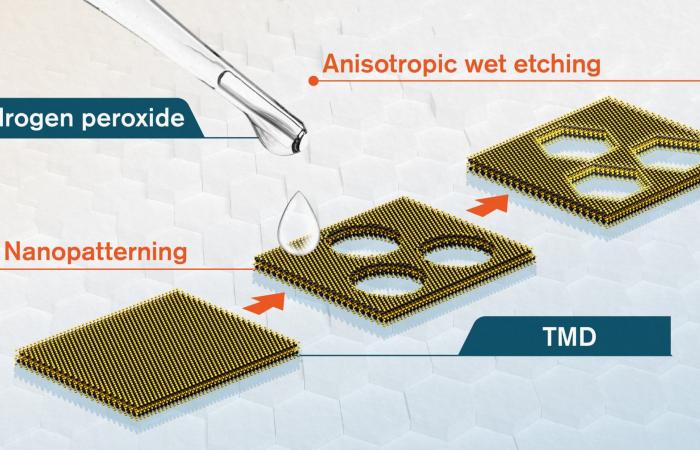Ultra-thin materials like graphene promise a revolution in nanoscience and technology. Researchers at Chalmers University of Technology, Sweden, published a study in Nature communication in which they introduce a method of controlling the edges of two-dimensional materials using a “magic” chemical.
“Our method makes it possible to control the edges – atom by atom – in a simple and scalable way using only mild heating along with abundant environmentally friendly chemicals like hydrogen peroxide,” says Battulga Munkhbat, a postdoctoral fellow at Chalmers University’s Department of Physics of Technology and first author of the paper.
Materials that are as thin as a single layer of atoms are known as two-dimensional or 2-D materials. The best-known example is graphene and molybdenum disulfide, its semiconductor analog. Future developments in this area could benefit from studying a particular feature inherent in such materials – their edges. Controlling the edges is a challenging scientific problem as they are very different from the main body of a 2D material. For example, a certain type of edge found in transition metal dichalcogenides (known as TMDs, such as the molybdenum disulfide mentioned above) can have magnetic and catalytic properties.
Typical TMD materials have edges that can come in two different flavors known as zigzags or armchairs. These alternatives are so different that their physical and chemical properties are not the same at all. For example, calculations predict that zigzag edges are metallic and ferromagnetic, while chair edges are semi-conductive and non-magnetic. Similar to these remarkable variations in physical properties, one might expect the chemical properties of zigzag and chair edges to be very different as well. In this case, certain chemicals may dissolve the chair edges and the zigzag remains untouched.
One such magical chemical is exactly what the Chalmers researchers found – in the form of common hydrogen peroxide. The researchers were initially completely surprised by the new results.
“It was not only that one type of edge dominated over the other, but also that the resulting edges were extremely sharp – almost atomically sharp. This shows that the ‘magic’ chemical works in what is known as a self-limiting way, removing unwanted material atom by atom, ultimately leading to edges at the atomically sharp boundary. The resulting patterns followed the crystallographic orientation of the original TMD material and produced beautiful, atomically sharp hexagonal nanostructures, “says Battulga Munkhbat.
“An extremely fascinating development”
The new process, which comprises a combination of standard top-down lithography processes with a new anisotropic wet etching process, therefore makes it possible to create perfect edges in two-dimensional materials.
“This method opens up new and unprecedented possibilities for Van der Waals materials (layered 2D materials). We can now combine edge physics with 2D physics in a single material. It’s an extremely fascinating development, ”says Timur Shegai. Associate professor at the Department of Physics in Chalmers and head of the research project.
These and other related materials often attract significant research attention as they enable critical advances in nanosciences and technologies. The potential applications range from quantum electronics to new types of nanodevices. These hopes are manifested in the graphene flagship, Europe’s largest research initiative of all time, coordinated by Chalmers University of Technology.
In order to make the new technology available to research laboratories and high-tech companies, the researchers founded a start-up company that offers high-quality atomically sharp TMD materials. The researchers also plan to further develop applications for these atomically sharp metamaterials.
One atom thin platinum is a great chemical sensor
More information:
Battulga Munkhbat et al., Transition Metal Dichalcogenide Metamaterials with Atomic Precision, Nature communication (2020). DOI: 10.1038 / s41467-020-18428-2
Provided by Chalmers University of Technology
Quote: Creating Perfect Edges in 2D Materials (2020, October 19), accessed October 19, 2020 from https://phys.org/news/2020-10-edges-d-materials.html
This document is subject to copyright. Except for fair trade for the purpose of private study or research, no part may be reproduced without written permission. The content is provided for informational purposes only.
These were the details of the news Creating perfect edges in 2-D materials for this day. We hope that we have succeeded by giving you the full details and information. To follow all our news, you can subscribe to the alerts system or to one of our different systems to provide you with all that is new.
It is also worth noting that the original news has been published and is available at de24.news and the editorial team at AlKhaleej Today has confirmed it and it has been modified, and it may have been completely transferred or quoted from it and you can read and follow this news from its main source.

